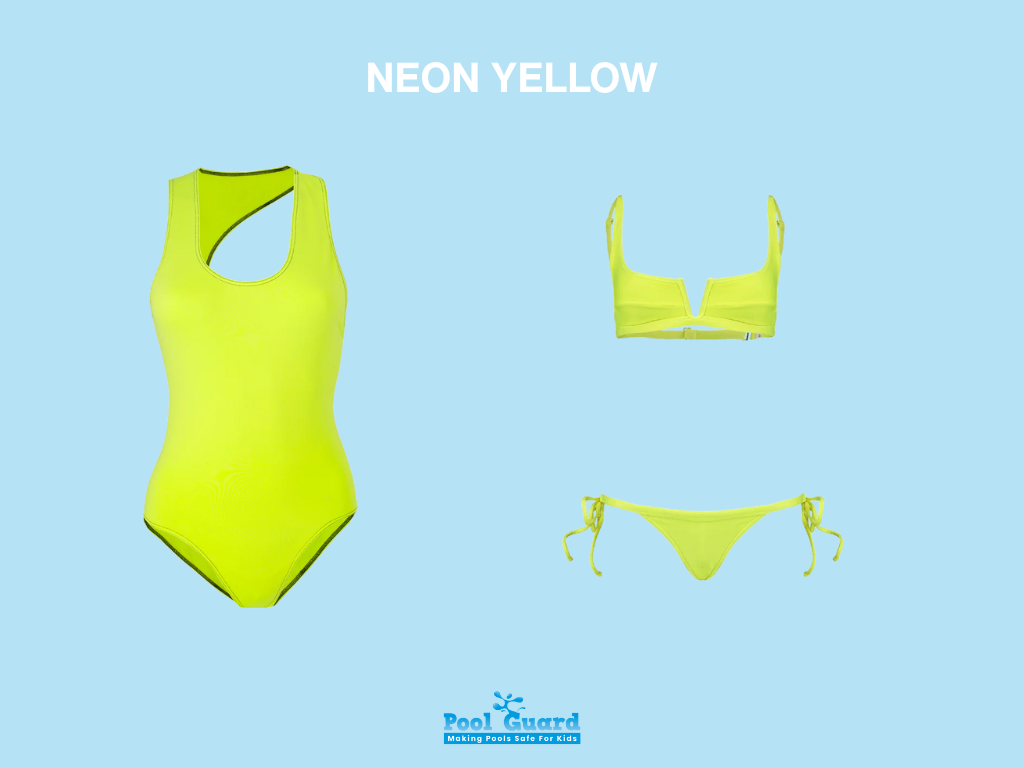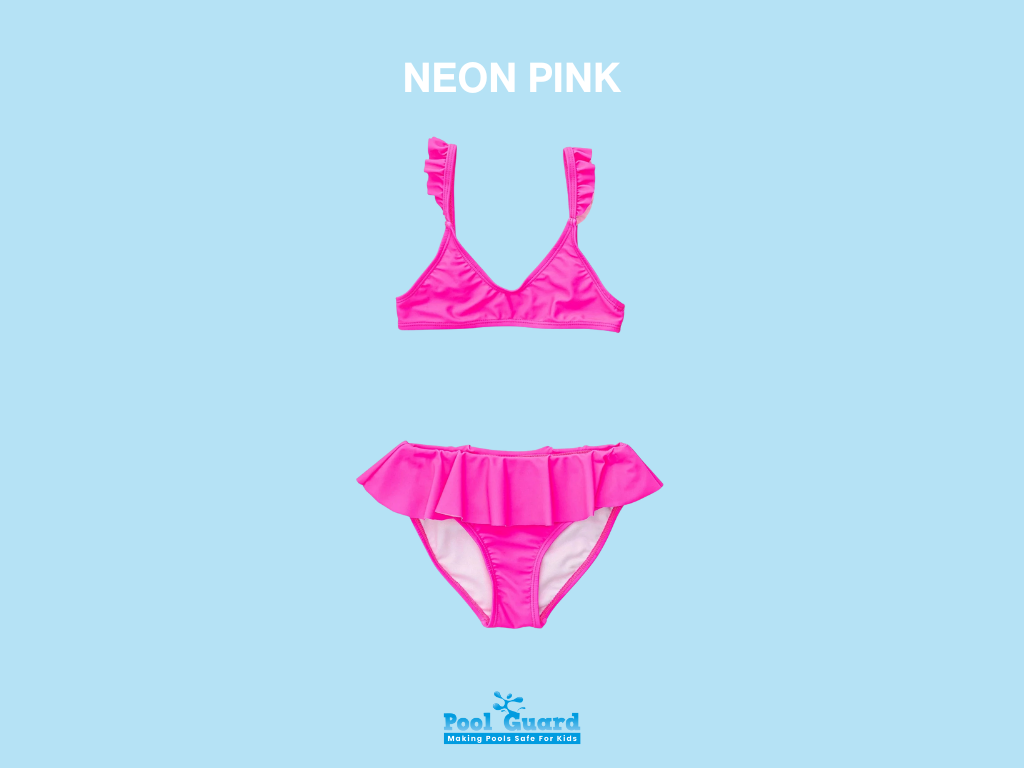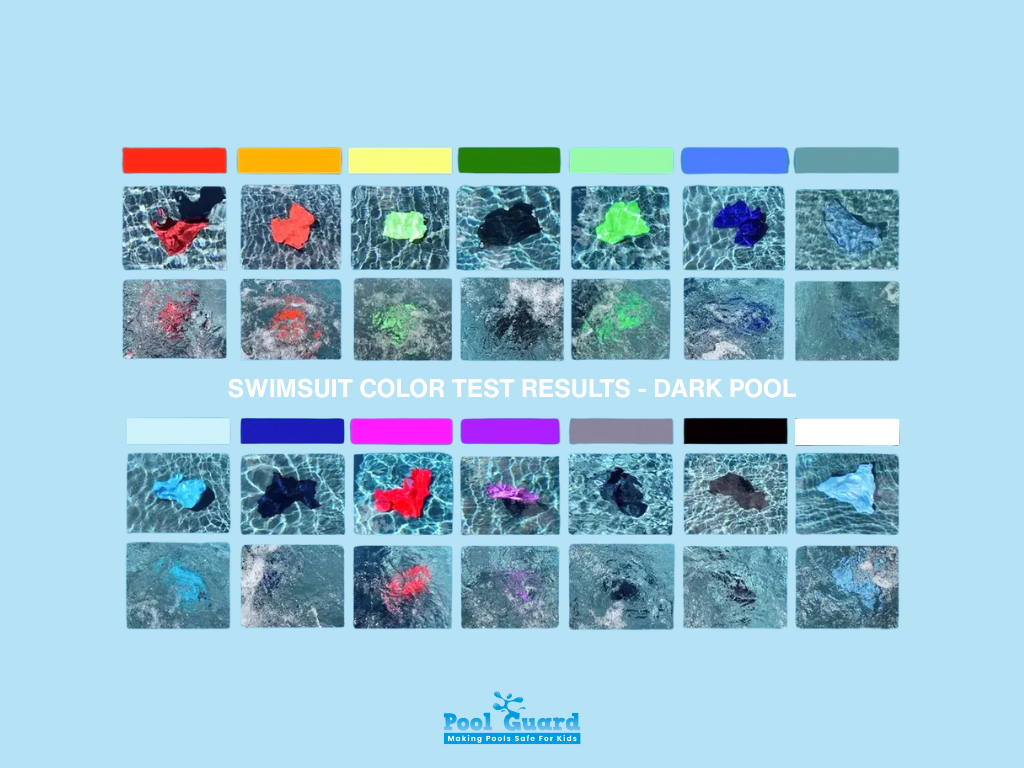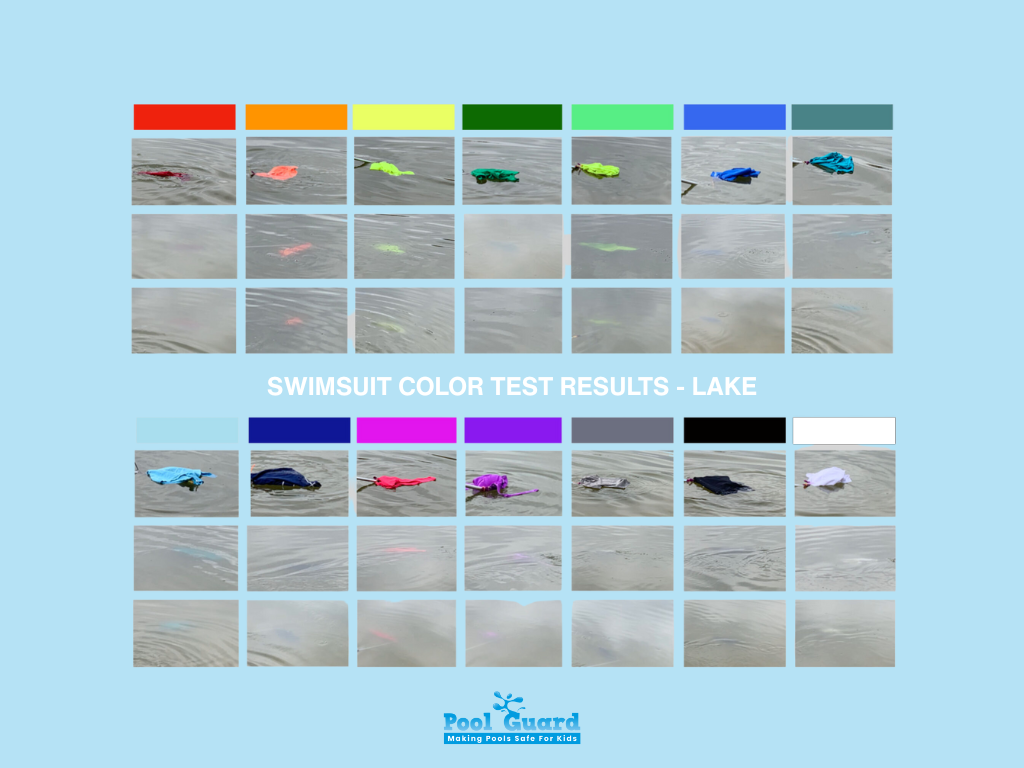Most parents choose swimsuits based on style, cuteness, or comfort. But underwater, none of that matters. What does matter is whether you can instantly see your child if something goes wrong and choosing the best swimsuit colors for safety plays a much bigger role than people realize.
The real cause of visibility failures has nothing to do with whether a color “looks bright” on land. It’s caused by:
Visibility testing shows that underwater visibility can drop 30–60% within the first 18 inches – especially for popular colors like blue, teal, white, and black.
Parents routinely overlook swimsuit color, even though it’s one of the few proactive drowning-risk reducers that can help during the seconds where recognition determines survival.
Of course, the safest step is preventing access entirely. That’s why layers of protection – like pool fences and self-latching gates – remain the most effective drowning-prevention tools.
But once a child is in the water, color determines how fast you can find them.
Let’s break down the science and find out what is the best color swimsuit to wear.
Water absorbs light unevenly. Longer wavelengths (reds, oranges) fade first. Shorter wavelengths (blue, green) penetrate deeper – but in the worst way: they blend with water.
This is why:
Brightness ≠ Visibility.
A bright pink swimsuit looks bold on land but becomes a low-contrast silhouette in water that’s also blue-green.
High Contrast = High Visibility
Parents consistently misunderstand this.
Visibility isn’t constant. It changes dramatically with:
Sand, silt, algae, and debris flatten visibility – especially in lakes and oceans.
Dark suits become indistinguishable from shadows.
Red/orange wavelengths vanish after just a few feet.
Absorbs red, orange, and pink first.
These environmental realities are why testing is essential – not assumptions.
ALIVE Solutions, a leading aquatic safety research group, tested 14+ swimsuit colors across:
This is the only widely referenced test using real-world conditions and the results were brutally clear.
Most swimsuit colors nearly disappear underwater.
Especially pastels, blues, dark tones, and fashion patterns.
But a few stood out dramatically.

Across all tests, three colors consistently performed best:
But here’s the part most blogs and retailers get wrong:
Neon orange is highly visible above water, but loses power underwater. Neon pink is very visible in pools, but almost invisible in lakes. And white? White vanishes under glare and mimics reflections.
Here’s a simplified visibility chart based on aggregated test results for safest bathing suit colors:
| Color | Pool Visibility | Lake Visibility | Why |
|---|---|---|---|
| Neon yellow | Excellent | Excellent | Strongest contrast, resists light loss |
| Neon green | Excellent | Good | Cuts through turbidity better than pink/orange |
| Neon orange | Good | Fair | Great above water, weaker underwater |
| Hot pink | Fair | Poor | Blends with shadows + low contrast in murky water |
| Blue/Teal | Terrible | Impossible | Same color as water—zero contrast |
This is exactly why tested data is more trustworthy than “bright colors look fine to me.”
Neon Yellow is the best swimsuit color for safety and underwater visibility. It has:
Professional rescue teams prefer neon yellow for a reason: it cuts through glare like no other pigment.

Slightly less dominant in dark, plant-heavy lakes where greens blend somewhat. Still a top-tier safety color.


This is a pool-only safety color – not universal.

Based on merging all the test results for the safest swimsuit colors for visibility, these are the absolute worst swimsuit colors for safety:
Reflects like glare, clouds, foam. Vanishes instantly in natural water.
Becomes the pool. In lakes, it dies instantly.
Disappears at almost every depth and in every water type.
Looks like shadows, debris, the pool bottom.
Blends fully with vegetation and murky water.
Turn into shimmer patterns that distort and confuse visibility.
Zero contrast. Zero utility underwater.
Break up the silhouette and destroy recognition.
If safety is the priority, these are non-starters.
Break up silhouette
Visibility changes dramatically depending on the water type. Here’s the ultimate cheat sheet:
Choose:
Why pink will also work here (to a depth of about 3–4 ft):
Pools have controlled clarity, light bottoms, and minimal algae.
Avoid:

These environments destroy contrast.
Best choices:
Avoid:

The surf introduces:
Best choices:
Toddlers disappear 2–3× faster in water than adults because:
That means visibility matters more for young children than any other age group.
Color helps detection.
Barriers prevent access.
| Color | Bright Light | Shade | Underwater | Distance Visibility | Murky Water Performance |
|---|---|---|---|---|---|
| Neon Yellow | ⭐⭐⭐⭐⭐ | ⭐⭐⭐⭐⭐ | ⭐⭐⭐⭐⭐ | ⭐⭐⭐⭐ | ⭐⭐⭐⭐⭐ |
| Neon Green | ⭐⭐⭐⭐⭐ | ⭐⭐⭐⭐ | ⭐⭐⭐⭐ | ⭐⭐⭐⭐ | ⭐⭐⭐⭐ |
| Neon Orange | ⭐⭐⭐⭐ | ⭐⭐⭐ | ⭐⭐ | ⭐⭐⭐⭐⭐ | ⭐⭐⭐ |
| Neon Pink | ⭐⭐⭐⭐ | ⭐⭐ | ⭐ | ⭐⭐ | ⭐ |
| Blue/Teal | ⭐ | ⭐ | 0 | ⭐ | 0 |
| White | ⭐ | ⭐ | ⭐ | ⭐ | 0 |
| Black/Navy | ⭐ | ⭐⭐ | ⭐ | ⭐ | ⭐ |
When choosing the best swimsuit color for visibility, combine:
Example:
– Neon orange rash guard + neon yellow trunks
– Neon lime trunks + neon pink top (pool only)
Contrast creates edge definition, making small bodies easier to identify in chaotic water.
Even neon colors can struggle when:
This is why layering color with vigilant supervision is essential.
The evidence is unmistakable – neon yellow and neon green are the best swimsuit colors for safety in any water. Neon orange follows closely behind, while most other colors – especially blue, black, pastels, and white – disappear dangerously fast underwater.
Visibility won’t prevent drowning, but it dramatically reduces response time in the moments that matter most. Combine high-visibility swimwear with the true prevention layers – pool fences, self-latching gates, alarms, and active supervision—to build a complete, reliable safety system.
Visibility reduces response time.
Barriers prevent emergencies.
If this guide helped you, share it.
Every parent deserves this information.
Please fill out the form below with your information. Your local dealer will be notified about your inquiry.
Please fill out the form below with your information. Your local dealer will be notified about your inquiry.